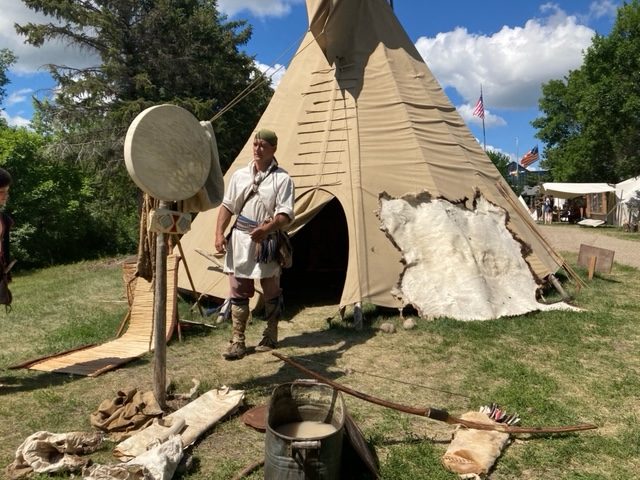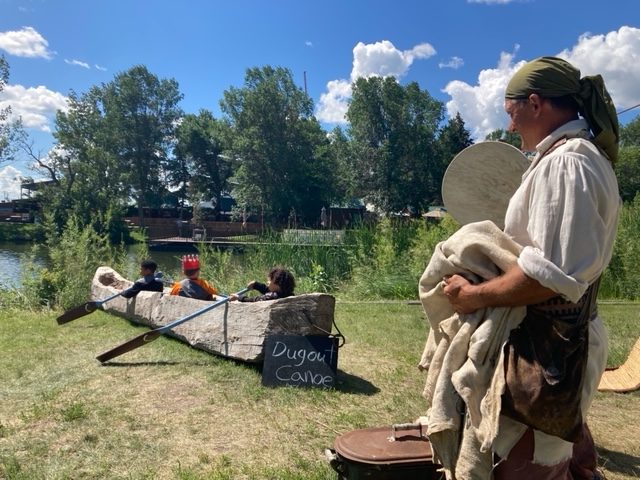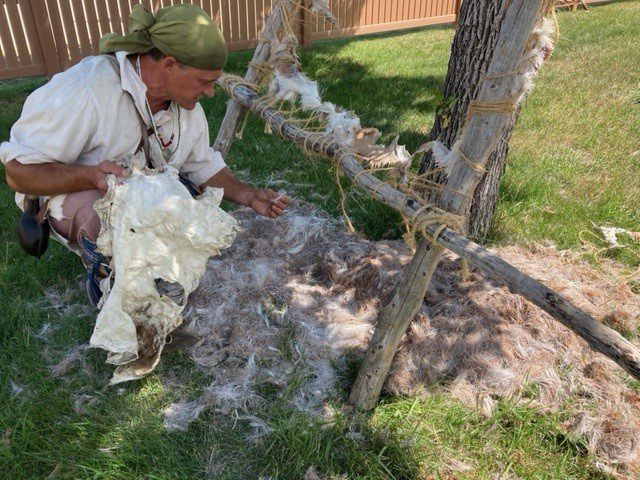

MINOT – Whether it's rawhide, cottonwood, or choke cherry trees, Jeremy Duckwitz, Moffit, can make almost anything a person needs to survive in the woods with no modern technology.
Surrounding his tent at the North Dakota State Fair is Duckwitz’s many crafts, tools, instruments, and even a canoe that he carved out of 7,000 pounds of cottonwood.

Duckwitz also makes his own rawhide, which he uses for knife holders, clothing, moccasins, drums, bags, and more.
“You take an animal hide when it’s wet, you lace it up on the frame, pull it tight, stretch it,” said Duckwitz.

After the hide is dry, Duckwitz then scrapes the animal hair and epidermis off the hide with a piece of a flint as the scraper and an elk antler as the handle.
Duckwitz said to make the hide into a softer material, he must use a process called brain tanning, where he soaks the now dry and clean hide in water mixed with the brains of animals.
“Every animal has enough brains to tan its own hide,” said Duckwitz. “You can use pig brains, deer brains, beef, whatever you have access to, and get it simmering good. The brains have the right ammino acids and enzymes to tend the hide.”
Duckwitz likened the process to soaking hard spaghetti noodles in water to soften it.
“So now you have brains in the pores, and now you need to start working the hide and stretching it,” said Duckwitz.
There are many ways to stretch the soft hide including stretching it on a tree, or in this case, using a rock.
Duckwitz said to keep the finished product soft, he must use rotten wood to create a smoky fire, which he lays the hide over in order to keep it soft. The smoke makes the hide waterproof, and erases the smell of brains, replacing it with the smell of smoke.
“You can’t use wet wood, otherwise the steam will scorch the hide,” Duckwitz explained.
Duckwitz also makes bows and arrows out of components he collects from the land.
“Red dogwood or chokecherry, that’s where you’d get the arrows from,” Duckwitz explained. “Then you’d have a flint knap arrowhead on the tip.”
Duckwitz wrapped his Osage Orange bow with snakeskin from North Dakota.
“This bow and arrow is actually quiet enough, I’ve missed deer and still got a second shot,” said Duckwitz. “That’s how quiet it is.”
Duckwitz also created a musical instrument called a jaw harp.
“You think about things you carry for entertainment, you’re sitting by the fire, and by itself it has no sound,” said Duckwitz. “You bite on it real lightly, and the sound reverberates in your mouth, and you move your tongue to adjust the pitch.”
Duckwitz said he’s been interested in creating these types of items ever since he was in fifth grade.
“A lot of people ask who taught me this,” said Duckwitz. “Probably mostly books.”
Duckwitz said he joined the Coalition of Historic Trekkers, where he will often go camping with a group from that organization without using any modern technology.
“I believe that we’re living lifestyles today that are so far outside of the circle of what we were meant to live, that I believe it’s the significance of our mental health issues,” Duckwitz described. “We’re relying too much on technology and machines.”
Duckwitz said his goal is to make it down the Missouri River from Garrison Dam to Bismarck with his dugout canoe and the traditional food, clothing, and bedding that he makes.